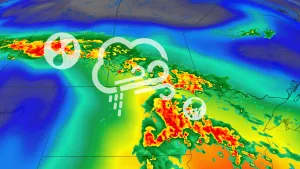
That's no tree stump! It's an immense icy impact crater on Mars!
Spacecraft circling Mars send back some amazing sights.
What looks like concentric growth rings in a tree stump are actually signs of water ice along the floor of an ancient crater on Mars.
The ExoMars Trace Gas Orbiter has been circling Mars for over five years now, capturing images of the planet's surface while the spacecraft investigates the thin Martian atmosphere.
On June 13, 2021, as ExoMars TGO swung around in one of its orbits, it flew over Acidalia Planitia, an immense lowland plain in the planet's northern hemisphere. In the process, a camera on the spacecraft known as the Colour and Stereo Surface Imaging System, or CaSSIS, snapped a picture of what would otherwise be a completely unremarkable crater.
From orbit, you'd likely never spot this particular crater. At the very least, it would be difficult to pick it out from the multitude of other small craters in the area.
Regardless, the image is quite spectacular.

This image from ExoMars TGO's CaSSIS camera Tap here to embiggen shows the walls and floor of a "small" crater in Mars' northern hemisphere, located at 51.9°N, 326.7°E in Acidalia Planitia. Credit: ESA/Roscosmos/CaSSIS, CC BY-SA 3.0 IGO
From this vantage point, it looks more like a tree stump viewed from above than an 8-kilometre wide crater that was blasted into the surface by some ancient asteroid impact.
According to the ESA: "The interior of the crater is filled with deposits that are probably water-ice rich. It is thought that these deposits were laid down during an earlier time in Mars' history when the inclination of the planet's spin axis allowed water-ice deposits to form at lower latitudes than it does today. Just like on Earth, Mars' tilt gives rises to seasons, but unlike Earth its tilt has changed dramatically over long periods of time."
"One of the notable features in the crater deposits is the presence of quasi-circular and polygonal patterns of fractures. These features are likely a result of seasonal changes in temperature that cause cycles of expansion and contraction of the ice-rich material, eventually leading to the development of fractures."

This false-colour hemisphere map of Mars plots elevation as measured by the Mars Orbiter Laser Altimeter (MOLA) instrument on NASA's Mars Global Surveyor. The location of this crater is indicated, as is the extent of Acidalian Planitia and past missions that are also in view. Credit: NASA/Google/Scott Sutherland
TGO is the first part of the overall ExoMars program. The next part of the mission launches later this year, with the Rosalind Franklin rover and its Kazachok lander expected to lift off in late September. If all goes as planned, they will arrive at Mars in June of 2023, bound for a landing in Oxia Planum, a region just to the south of Acidalia Planitia. Once there, the Franklin rover will explore the area, drilling down into the clay-bearing sediments of the region, looking for signs of past (and possibly even present) life.










